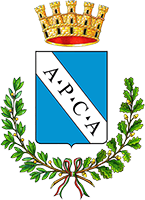OF ST. AUGUSTINE

OF ST. AUGUSTINE
The church of St. Augustine was built over an earlier parish church dedicated to St. Pancras. In 1266 the Augustinian Bishop of Narni, Orlando, established the first Augustinian community of friars in Amelia. The church was consecrated in 1288 and it is considered a Gothic-style building: the exterior preserves its original appearance, and the fine polygonal apse, that can be seen from via Posterola, is especially remarkable. Its high and thin mullioned windows had been later stopped up with bricks.
The pointed arch doorway has a rich articulation of jambs, small columns and friezes decorated with allegorical low-relief scenes representing vine shoots and imaginary and monstrous animals. The lunette above the door hosts a fresco depicting Madonna with Child between St. Augustine, St. Nicholas from Tolentino and musician angels, attributed to the fourteen century Sienese School. The upper section of the façade instead, is not that original of the thirteen-century building: it collapsed in 1449 and it was rebuilt in 1477, thanks to the generosity of Angelo I Petrignani, who supported its restoration. For this reason, the Petrignani family coat-of-arms sits beneath a fine rose window.
The single-nave church was completely altered in Baroque style between 1742 and 1762, though maintaining the original terracotta paving. Over the centuries, the church of St. Augustine became a privileged burial place for some of the most important aristocratic families of Amelia, among which the Cansacchi family, whose funeral memories are still preserved in the church.
Among the works of art that the church conserves, we can find the following paintings: St. John the Evangelist on Patmos with Saints Augustine and Charles Borromeo by Antonio Circignani, known as Il Pomarancio (Città della Pieve, about 1568 – Rome 1629), which is dated around 1613 and it is the only certain statement of the documented activity of the Mannerist painter in Amelia; The Trinity venerated by Saints Monica, Rita and Clare of Montefalco attributed to Giacinto Gimignani (Pistoia 1606 – Rome 1681); the frescoes by Francesco Appiani (Ancona 1704 – Perugia 1792), both in the apse (Nativity of Jesus, Martyrdom of St. Pancras and Holy Family with St. Anne and the Infant John) and in the dome (Glory of St. Augustine), dated 1746 – 1750.
Worth noting: Above the entrance, there is an organ, made in 1841 by Angelo Morettini of Perugia; the Gothic architecture of the Sacristy is very fine, with its ribbed cross-vault ceiling and, on the walls, peculiar sinopites, that is preparatory drawings for frescoes, made by a reddish drawing chalk known as sanguine; the doorway that leads to the convent; the courtyard, began in 1492 by the Lombard architect Martino Tartaglia. Recently, some frescoes’ fragments, clearly influenced by the Raphael School (Virgin with Child and a figure of St. Rocco) and dated back around the first half of the 16th century, have emerged from a former convent room, that was earlier used as location for the Civic Museum and afterwards as a public school.


